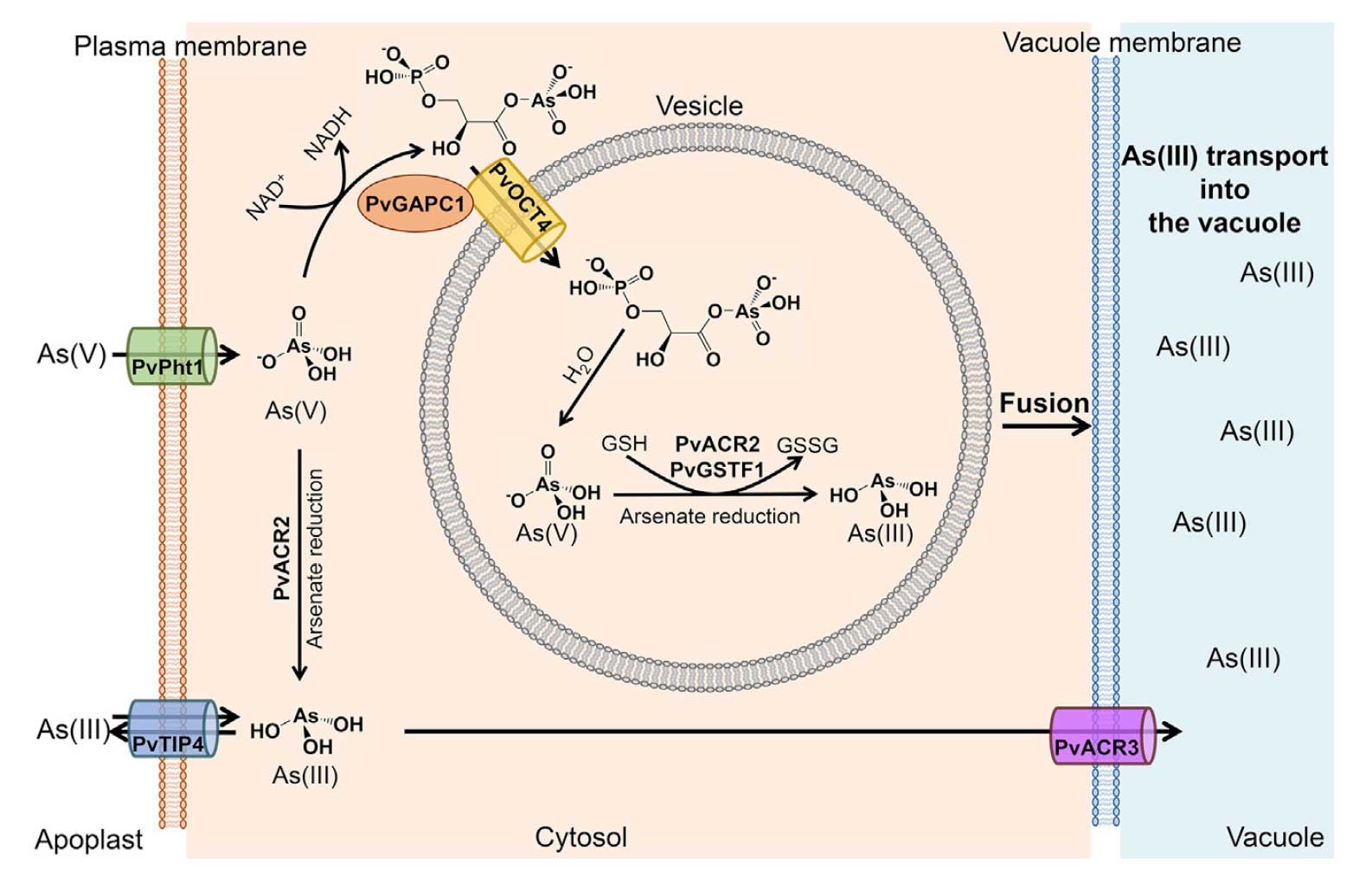博文
Current Biology:凤尾蕨高砷抗性的分子机制
||
Three Genes Define a Bacterial-Like Arsenic Tolerance Mechanism in the Arsenic Hyperaccumulating Fern Pteris vittata
First author: Chao Cai; Affiliations: Purdue University (普渡大学): West Lafayette, USA
Corresponding author: Jo Ann Banks
Arsenic is a carcinogenic contaminant of water and food and a growing threat to human health in many regions of the world. This study focuses on the fern Pteris vittata (Pteridaceae), which is extraordinary in its ability to tolerate and hyperaccumulate very high levels of arsenic that would kill any other plant or animal outside the Pteridaceae. Here, we use RNA-seq to identify three genes (GLYCERALDEHYDE 3-PHOSPHATE DEHYDROGENASE (PvGAPC1), ORGANIC CATION TRANSPORTER 4 (PvOCT4), and GLUTATHIONE S-TRANSFERASE (PvGSTF1) that are highly upregulated by arsenic and are necessary for arsenic tolerance, as demonstrated by RNAi. The proteins encoded by these genes have unexpected properties: PvGAPC1 has an unusual active site and a much greater affinity for arsenate than phosphate; PvGSTF1 has arsenate reductase activity; and PvOCT4 localizes as puncta in the cytoplasm. Surprisingly, PvGAPC1, PvGSTF1, and arsenate localize in a similar pattern. These results are consistent with a model that describes the fate of arsenate once it enters the cell. It involves the conversion of arsenate into 1-arseno-3-phosphoglycerate by PvGAPC1. This “chemically trapped” arsenate is pumped into specific arsenic metabolizing vesicles by the PvOCT4 protein. Once inside these vesicles, 1-arseno-3-phosphoglycerate hydrolyses to release arsenate, which is then reduced by PvGSTF1 to arsenite, the form of arsenic stored in the vacuoles of this fern. This mechanism is strikingly similar to one recently described Pseudomonas aeruginosa, whose tolerance to arsenic also involves the biosynthesis and transport of 1-arseno-3-phosphoglycerate, indicating that P. vittata has evolved a simple, bacterial-like mechanism for arsenic tolerance.
砷是一种水和食物中的致癌污染物,并全球多个地区对人类安全的威胁日益增长。本文研究了对砷具有非常高的抗性的蕨类植物凤尾蕨,凤尾蕨能够过量积累砷,其植株中包含的砷含量对于凤尾蕨科以外的其他植物或是动物都是致命的。本文,作者通转录组测序鉴定了甘油醛3-磷酸脱氢酶PvGAPC1、有机阳离子转运蛋白PvOCT4和谷胱甘肽S-转移酶PvGSTF1等三个基因在砷处理后显著上调,并且通过RNA干扰技术证明了这三个基因对于凤尾蕨的砷抗性是必需的。这三个基因编码的蛋白具有意想不到的特性:PvGAPC1具有一个不同寻常的位点,并且对于砷酸盐的亲和力要比磷酸盐更强;PvGSTF1具有砷酸还原酶活性;而PvOCT4则在细胞质中形成一个个聚集点。有趣的是,PvGAPC1、PvGSTF1和砷酸盐的定位模式类似。这些结果与模型预测的砷酸盐进入细胞后的命运一致。该过程包括砷酸盐被PvGAPC1转换为1-砷-3-磷酸甘油酯。经过转换后,砷酸盐会被PvOCT4蛋白泵入到特定的砷代谢囊泡中。一旦砷酸盐进入到这些小泡中,1-砷-3-磷酸甘油酸会水解释放出砷,从而被PvGSTF1还原为亚砷酸盐,从而以这样的方式储存在凤尾蕨的液泡中。这种机制与最近报道的铜绿假单胞菌中的机制十分相似,铜绿假单胞菌对于砷的抗性同样涉及1-砷-3-磷酸甘油酸的合成和转运,说明凤尾蕨已经演化出了一个简便的、与细菌类似的抗砷机制。
通讯:Jo Ann Banks(https://www.purdue.edu/gradschool/pulse/groups/profiles/faculty/banks.html)
研究方向:卷柏基因组;凤尾蕨中砷过度积累的分子基础;水蕨属物种中决定性别分化的信息素。
doi: https://doi.org/10.1016/j.cub.2019.04.029
Journal: Current Biology
Published date: May 09, 2019
https://blog.sciencenet.cn/blog-3158122-1179188.html
上一篇:Plant Physiology:水稻分生组织维持的遗传调控机制
下一篇:Nature Genetics:番茄泛基因组
全部作者的其他最新博文
- • Plant Physiology:CsMADS3促进柑果中的叶绿素降解和类胡萝卜素合成(华中农业大学)
- • Molecular Plant:LBD11-ROS反馈调节作用于拟南芥的维管形成层增殖和次生生长(浦项科技大学)
- • Science Advances:根结线虫通过调控植物的CLE3-CLV1模块,促进侵染进程(日本熊本大学)
- • Nature Communications:油菜素内酯参与植物营养生长期转变的分子机制解析(浙江农林大学)
- • Current Biology:光合作用产生的蔗糖驱动侧根“生物钟”(德国弗莱堡大学)
- • PNAS:花同源异型基因在叶中被抑制、花中被激活的分子机制(南卡罗来纳大学)

